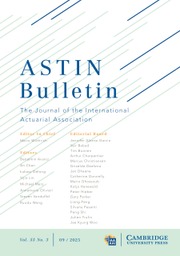No CrossRef data available.
Article contents
Fairness and risk sharing in integrated LRD-tontine schemes under Volterra mortality risk
Published online by Cambridge University Press: 31 July 2025
Abstract
As the global elderly population expands, the associated risks of longevity intensify, presenting significant challenges to traditional retirement security systems. We study actuarial fairness in tontines under the Volterra mortality framework, integrating long-range dependence mortality models rates with tontine structures. Initially, we establish an optimal tontine model for a homogeneous tontine under this framework. However, according only to individual actuarial fairness can neglect the collective nature of tontines. So we propose a hybrid optimization model that accounts for age and wealth discrepancies affecting payment amounts and the collective fairness. Specially, we first apply the f-value fairness measure in age-heterogeneous tontines for assessing fairness. Our results reveal that while the model ensures actuarial fairness at the group level, relative payments are lower for older age groups. By incorporating dynamic mortality modeling through the Volterra mortality framework, our work demonstrates that this comprehensive scheme significantly enhances the robustness and sustainability of retirement security systems. These findings provide valuable insights for the future integration of dynamic mortality models with innovative retirement income structures.
Information
- Type
- Research Article
- Information
- ASTIN Bulletin: The Journal of the IAA , Volume 55 , Special Issue 3: Risk Sharing , September 2025 , pp. 644 - 667
- Copyright
- © The Author(s), 2025. Published by Cambridge University Press on behalf of The International Actuarial Association

